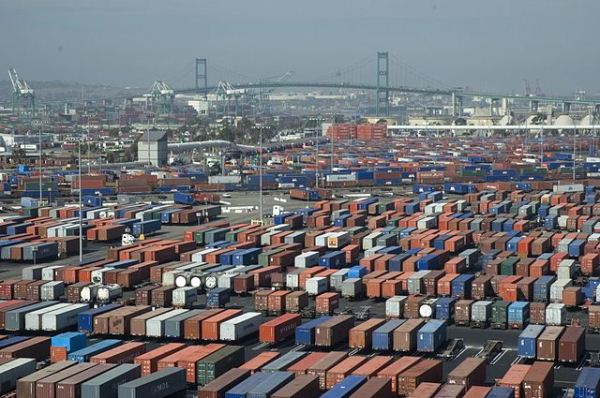-
On the USWC, loaded imports were up by 25.3% in January and February, exceeding 2 million TEUs for the two months for the first time
-
Imbalance has widened as US imports post record high levels while exports have fallen considerably
-
Congestion and long waiting times at major West Coast ports have left many shippers looking to air freight, while some carriers are diverting courses to avoid the busiest US ports
-
US appetite for goods is seen to drop once service spending starts to recover, but high freight rates are unlikely to disappear anytime soon
Import volumes at US container ports were still rising in January and February even as US exports have been falling, increasing the trans-Pacific trade imbalance, according to a new Baltic and International Maritime Council (BIMCO) analysis.
BIMCO said imports handled by the San Pedro Bay ports of Los Angeles and Long Beach on the US West Coast (USWC) rose 27.8% to reach 1.6 million twenty foot equivalent units (TEUs) in the first two months of 2021 compared to the same period in 2020.
For the entire USWC, loaded imports were up by 25.3% over 2020 and exceeded 2 million TEUs in January and February for the first time in history.
But there were also signs of slowing, BIMCO observed. The 986,555-TEU laden containers imported in February were the first time that monthly imports had dipped below 1 million TEUs since July 2020.
Imports in February 2021 were, however, still the highest ever recorded for the month by the USWC.
Total throughput, which includes both imports and exports at the USWC ports, was up 12.6% in the first two months from the same period in 2020 to reach 2.7 million TEUs handled.
“Although spot freight rates have eased in recent weeks from record highs, high freight rates will not disappear any time soon,” said Peter Sand, BIMCO’s chief shipping analyst.
“This is due to the continued strength of US imports in combination with disruption from the transpacific trade that has affected the rest of the container shipping market.”
But while US imports have posted record high levels, exports have fallen considerably. The ratio between loaded imports and loaded exports has risen to 4:1 at the port of Los Angeles, and to 2.7:1 for all USWC ports.
In the first two months of this year, loaded container exports from the USWC declined by 11.8% compared to the first two months of 2020, standing at 734,534 TEUs. Exports of empty containers, on the other hand, have risen by 27.6% to reach 1.4 million TEUs.
BIMCO said the congestion and long waiting times at the major West Coast ports have left many shippers looking for viable alternatives, including the costlier air freight to ensure the cargo reaches customers on time. For some carriers it has meant diverting container ships to avoid the busiest US ports.
These diversions include switching to options further north, such as Oakland and Tacoma-Seattle, as well as the farther ports in the US Gulf of Mexico, including the port of Houston, where inbound container volumes increased by 17.4% in the first two months of this year compared to 2020.
Looking ahead, BIMCO expects US demand to still remain strong and the current backlog to take many months to clear, although the appetite for goods will drop as service spending starts to recover.
The new US$1.9 trillion stimulus package will boost consumer spending and support a strong rebound in the US economy in 2021, it predicted.
Already in the first two months of this year, US retail sales have grown by 8.4% compared with the start of 2020, although February 2021 sales registered the lowest level since April 2020 when stores closed due to the pandemic.
BIMCO said, however, that with the current US vaccination program and many states starting to lift restrictions, the share of service spending will start to recover as consumers face more options on where to spend their money.
With a rise in service spending and the high inventory/sales ratio, US demand for containerized imports cannot remain at its current levels for many more months, said Sand. “Once the current surge is dealt with and the backlog is cleared, which alone will take several months, container volumes and the spot freight rates will fall,” he continued.
“However, even as the spot market comes down from its highs, carriers’ profitability is already assured this year as high-volume long-term contract rates are being locked in at very high rates for the next many months to come.”
He said this means that for carriers, “their bottom line is set for another successful year in 2021.”
Photo by Charles Csavossy





